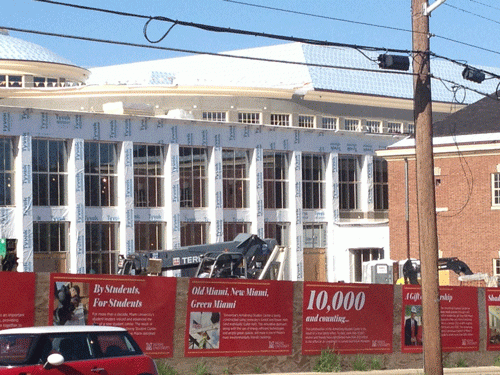
Miami University debt is financing numerous projects including the $50 million Armstrong Student Center (ASC). (JM Rieger | The Miami Student)
The following article is part three of a three-part series on education at Miami University.
Facility improvements over the last decade have led to record debt levels while Miami University students are often left footing the bill, according to analysis by The Miami Student.
Miami's total debt grew from more than $44 million in 2002 to more than $427 million last year, an 866 percent increase and the fourth-highest debt total in Ohio, while total interest owed grew more than 1,100 percent, before adjusting for inflation. Rising debt levels have funded facility improvements that will eventually cost the university between $600 and $700 million.
Meanwhile, long-term debt increased more than 263 percent during that time and grew nearly 39 percent between 2002 and 2008, compared to 12 percent nationally, according to a report published last year by Bain & Company and Sterling Partners. Rising debt has created a "liquidity crisis" in higher education, as many institutions are now overleveraged by excessive costs, according to the report.
Miami's operating expenses, funded largely by student tuition and fees, increased more than 38 percent between 2002 and 2012, while in-state tuition increased more than 85 percent and out-of-state tuition increased more than 70 percent. Meanwhile, academic spending increased 36 percent while total state support decreased less than 15 percent during that time, from $82 to $70 million.
Declining state support and soaring university debt have led to rising tuition, according to economists, although oftentimes students are paying more for less, hurting the classroom experience.
"We have gotten ourselves locked into [an] amenity arms race, which is an incredibly expensive game to play and it's almost like Division I athletics, where it gets more and more expensive each year to play it," James Brock, a Miami economics professor said. "You have doubled your expenditures for ... essentially the same number of students. At some point it's not sustainable ... universities seem to be focused on the revenue side rather than the cost side."
As costs increased over the last decade, university enrollment and instructional faculty hiring remained relatively flat. Miami's undergraduate enrollment decreased nearly 3 percent over the last 10 years, while total enrollment increased 4 percent and the number of instructional faculty increased less than 10 percent, according to the Common Data Set.
According to university officials though, decreased state funding has led to rising costs while facility improvements are necessary for upkeep and to give Miami a competitive advantage.
"Students, families evaluate us based upon rankings; rankings are heavily based upon how much institutions spend per student, so it's difficult to compare that then to affordability if you look at it solely in what's the least expensive way to provide a baccalaureate education," Vice President for Finance and Business Services David Creamer said. "So our challenge is always trying to figure out how do we balance between those [factors]? At the same time, we have to take into consideration the financial impact this has for students."
Enjoy what you're reading?
Signup for our newsletter
As costs and debt have increased at Miami, wealthier students and record student-debt levels have helped finance facility improvements as tuition nationally continued to capture a larger percentage of median family incomes. Cumulative debt grew nearly 55 percent while more than 30 percent of last year's freshman class reported family incomes greater than $200,000.
Meanwhile, analysts are increasingly questioning the financial strength of institutions amid concerns of higher education's return on investment.
Miami's total liabilities increased more than 370 percent over the last decade, while the university's equity and expense ratios decreased between 2002 and 2008, indicators of financial strength. However, like 40 percent of the colleges and universities analyzed in the Bain report, Miami was financially sound in 2008, although its total debt has increased nearly 92 percent since then. This debt has financed campus projects including the $35 million Goggin Ice Center, the $50 million Armstrong Student Center and the $84 million East Quad renovation.
But according to officials, the university has controlled costs and improved facilities, providing a strong student experience and return on investment.
"If we make it so affordable that the long term benefits are diminished, then I think we will have failed; if we make it so expensive that no one can afford the experience, then we've also failed," Creamer said. "The reality was, while we had taken very good care of those buildings, the average age was over 60 years since there was a major improvement made, and it was simply a necessity that we make a significant investment if we're going to continue to provide an appropriate residential experience."
But as administrative costs outpace instructional costs, critics question if universities are allocating resources appropriately as they increasingly compete for top rankings.
"I'm afraid it is almost entirely all about rankings," Brock said. "It's all about hype and PR and boasting and rankings ... I think we rank highest in terms of our insanity over rankings. I think if we got back to concentrating on the game we play on the field and in the court rather than focused on the scoreboard of rankings, I think we would probably be happier and healthier; we'd also have lower costs."
According to student leaders though, facility improvements are not only necessary, but help Miami remain competitive in Ohio and nationwide.
"It's important to create reasons why students want to come to a campus," Miami's incoming Student Body President Charlie Schreiber said. "If you don't constantly keep building, keeping up with the times, then you're going to lose a large percentage of people that actually want to come to a school. So I think by taking on this debt, by building these new buildings, it's actually an investment for our future."






